|
 |
|
|
|
|
|
|
|
|
|
|
|
|
|
|
|
|
|
| Exploring Monuments of Delhi |
|
|
| About Delhi |
|
|
 |
|
| Travel Destinations Guide |
|
|
| Adventure Tours India |
|
|
|
|
 |
Biking Tours |
 |
Paragliding |
 |
Skiing |
 |
Safari Tours |
 |
Water Rafting |
 |
Trekking Tours |
 |
Camel Safari |
|
|
| |
|
|
|
|
|
|
|
|
|
| Temples of Delhi |
|
|
 |
|
| Historical Forts of Delhi |
|
|
|
| Exploring Monuments - Delhi |
|
| Back |
Delhi is a city with an impressive and remarkable history. Standing as a witness to this interesting bygone era are the various monuments of Delhi. From the Old Fort to the Tughlaqabad area to the various tombs in the city, each one represents a separate period in the history of Delhi. In the area of New Delhi, historical monuments cover mostly those that were built during the time of the British like the Parliament House, President's House, the India Gate etc.
However, one thing that is common in all the monuments of Delhi is their architectural excellence. Be it the Red Fort built by Shah Jahan or the Parliament House designed by Edwin Lutyens, each and every monument has an architectural beauty that leaves you mesmerized. All said and done, the magnificence of Delhi monuments cannot be fully described and you will have to visit them to really appreciate them.
 India Gate, Delhi India Gate, Delhi
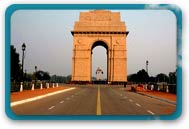 This solemn monument was built in memory of the 90,000 Indian soldiers who died in World War I. It was built in 1931, designed by Lutyens, and was originally called the All India War Memorial. The names of the soldiers are inscribed on the walls of the arc of the gate. Later in 1971, an eternal flame was lit here in memory of the unknown soldiers who died in the 1971 Indo-Pakistan war. India Gate stands at the end of Rajpath, and is a popular picnic site especially during hot summer evenings. At night, the Gate is brightly lit and the fountains near the Gate are lit with coloured lights. The sight is delightful. This solemn monument was built in memory of the 90,000 Indian soldiers who died in World War I. It was built in 1931, designed by Lutyens, and was originally called the All India War Memorial. The names of the soldiers are inscribed on the walls of the arc of the gate. Later in 1971, an eternal flame was lit here in memory of the unknown soldiers who died in the 1971 Indo-Pakistan war. India Gate stands at the end of Rajpath, and is a popular picnic site especially during hot summer evenings. At night, the Gate is brightly lit and the fountains near the Gate are lit with coloured lights. The sight is delightful.
 Qutub Minar at Delhi Qutub Minar at Delhi
 Qutub Minar was constructed in 1192 by Qutab-ud-din Aibak, by the founder of Slave Dynasty and later completed by his son-in-law and successor Iltutmish. The Qutub Minar is the tallest brick minaret in the world. Built exclusively in red brick and sandstone this minaret in Delhi is an exquisite example of Indo-Islamic Afghan architecture. Qutub Minar was constructed in 1192 by Qutab-ud-din Aibak, by the founder of Slave Dynasty and later completed by his son-in-law and successor Iltutmish. The Qutub Minar is the tallest brick minaret in the world. Built exclusively in red brick and sandstone this minaret in Delhi is an exquisite example of Indo-Islamic Afghan architecture.
Qutub Minar at Delhi is a 5 storied tower. Each tower of the famous Qutub Minar has unique designs. It was hit by lightening twice. Due to this hazard, there was major damage in the structure. But during the reign of Muhammad-bin-Tughlaq, the king repaired the ensuing damage. Again during the reign of Emperor Feroze Shah Tughlaq, when the top most storey of the Qutub Minar was destroyed, the king repaired the floor and elevated the Qutub Minar to another level.
 Jantar Mantar Delhi Jantar Mantar Delhi
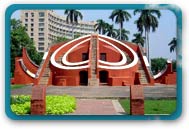 Jantar Mantar was built in 1724 by Raja Jai Singh II of Jaipur in Delhi. Jantar Mantar of Delhi, is an astronomical observatory with masonry instruments. Jantar Mantar in Delhi is a remarkable and curious creation of Raja Jai Singh II, the mathematician and astronomer king. Jantar Mantar has instruments that can graph the path of the astronomical universe. Jantar Mantar was built in 1724 by Raja Jai Singh II of Jaipur in Delhi. Jantar Mantar of Delhi, is an astronomical observatory with masonry instruments. Jantar Mantar in Delhi is a remarkable and curious creation of Raja Jai Singh II, the mathematician and astronomer king. Jantar Mantar has instruments that can graph the path of the astronomical universe.
The name of this noteworthy astronomical observatory, Jantar Mantar means 'instrument for calculation.' There is a colossal Samrat Yantra at the periphery of Jantar Mantar. To the south of Samrat Yantra there is an amazing instrument called Jai Prakash. The Jai Prakash of Jantar Mantar in Delhi has two concave hemispherical structures and used for determining the position of the sun and celestial bodies. Jantar Mantar is built of brick rubble that is plastered in lime. You can see the following instruments inside the Jantar Mantar of Delhi.
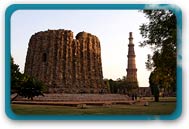  Humayun's Tomb Humayun's Tomb
The famous Humayun's Tomb of Delhi is the first garden tomb in India. A complex commissioned in 1562 CE by Hamida Banu Begum Humayun's wife and designed by Mirak Mirza a Persian architect this monument is one of the first specimens of Mughal architecture in the Indian subcontinent. Located on the banks of the River Yamuna this structure was declared a UNESCO Heritage site in 1993.
The famous Humayun's Tomb of Delhi is considered to be the precursor of the 'Taj Mahal' as far as the architectural structure is concerned. It represents the Mughal style of architecture at its best. One of the major attractions in the city this mausoleum serves as the burial ground of several Mughals apart from the emperor himself.
  Parliament House Delhi Parliament House Delhi
Parliament House accommodates the two Houses of Parliament, Lok Sabha (House of the People) and Rajya Sabha (Council of States). Sir Edwin Lutyens and Sir Herbert Baker, the architects of New Delhi, designed this building. His Royal Highness, the Duke of Connaught, laid the foundation stone of Parliament House in the year 1921. It took six years to complete the Delhi Parliament House and its was inaugurated in the year 1927 by the then Governor-General of India, Lord Irwin. A circular building, it also houses ministerial offices, a number of committee rooms and a brilliant library.
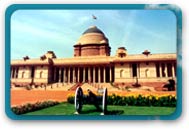  Rashtrapati Bhavan Rashtrapati Bhavan
It was decided in the Delhi Durbar of 1911 that the capital of India would be shifted from Calcutta to Delhi. Thus was born the city of Delhi, designed by the great architect Edwin Lutyens, along with Herbert Baker. It took approximately 20 years and 15 million pounds to build New Delhi. Built as the Viceral Lodge, Delhi Rashtrapati Bhawan comprises of four floors and 340 rooms. Now known as the President House of New Delhi, it is spread over an area of approximately 200,000-sq-feet. It took 18 years to construct this building and on the on the 18th year of its completion, India became independent.
The Jaipur Column, a gift from the Maharaja of Jaipur, stands at a height of 145 m in the middle of the main court in front of the Rashtrapati Bhavan. Another one of the impressive features of the Delhi Rashtrapati Bhawan comprises of the outstandingly beautiful Mughal Gardens. Then, at the base of the building, is a spacious square, known as the Vijay Chowk. The massive neo-Buddhist copper dome of the President House of New Delhi is splendid and can be seen even from a distance of a kilometer. Underneath this fabulous dome is the circular Durbar Hall, housing the Viceroy's throne, measuring almost 22.8 m in diameter. Before the National Museum was completed, it served as a museum for a number of years. All the official ceremonies such as the swearing in of the Prime Minister, the Cabinet and the Members of Parliament, etc., take place in this hall only. Also, the Arjuna Awards for Excellence are awarded by the President from here itself. On the ground floor of the Rashtrapati Bhavan are a number of state apartments. Then, there is the State Drawing Room, State Ballroom, State Dining Room and a number of other such rooms inside the building. The Delhi Rashtrapati Bhawan consists of 54 bedrooms, along with additional accommodation for guests.
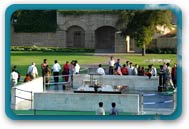  Raj Ghat at Delhi Raj Ghat at Delhi
Rajghat is only 4 kilometers away from Janpath in New Delhi. Rajghat at Delhi is adjacent to Feroz Shah and Delhi Gate on the Ring Road from where you can view the Yamuna river. In Rajghat, Mahatma Gandhi's last rituals were performed on 31st January, 1948. You can see the memorial stone of Gandhiji in square shaped black stone when you visit this famous Rajghat in Delhi.
The Rajghat at Delhi is visited by the nationals as well as by the foreigners who wishes to pay their homage to Mahatma Gandhi. Beside Rajghat of New Delhi, you will find a Gandhi Memorial Museum. The museum displays the life cycle of the great soul and the philosophy of the Sarvodaya Movement through a movie. If you want to see the show in English the timing is from 9.30 am to 5.30 pm except Thursdays. On Sundays the show is shown at 3 pm in Hindi and at 5 pm in English.
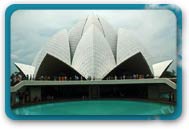  Lotus Temple Lotus Temple
Lotus Temple is situated 12 km to the southeast of Connaught Place. Architecturally one of the most splendid temples of India, Delhi Lotus Temple is called so because it is built in the shape of a Lotus flower. The temple got completed in the year 1986 and rises to a height of more than 40 m. Located on Bahapur Hills, it is the seventh and the latest Baha'i houses of worship in the world. Bahai Temple of New Delhi is a white marble monument designed like a half-opened lotus.
There is a simple, but outstanding 34.27 m high central hall in the temple where people sit and meditate. Petal alcoves of the temple are inscribed with stimulating quotes of the Baha'i sacred scriptures. Though the temple belongs to the Baha'i sect, it is open to people of each and every faith. The Baha'i religion, an independent one, places great importance on prayer and meditation as instruments for the progress of the human soul. Committed to the oneness of all religions and mankind, it traces its origins to its prophet Baha'u'llah, born in Persia in the 20th century.
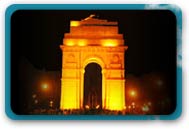  India Gate India Gate
India Gate is a war memorial of martyred soldiers, situated in the middle of New Delhi. Standing tall at a height of 42 m, Delhi India Gate, an "Arc-de-Triomphe", seems like a gateway at the heart of a crossroad. His Royal Highness, the Duke of Connaught laid the foundation stone of India Gate in the year 1921. Designed by Edwin Lutyens, the monument was dedicated to the country after 10 years, by the then Viceroy, Lord Irwin. It stands as a tribute to the 70,000 Indian soldiers who lost their lives during World War I, when they fought for the British Army.
Resting on a low foundation of red Bharatpur stone, the arch rises in stages to a huge molding. On both the sides of the arch the word INDIA is inscribed, along with the date, MCMXIV (1914) on the left and MCMXIX (1919) on the right. The best time to see Delhi India Gate is during nightfall, when it is magnificently floodlit. Splendid lawns, with a number of fountains, encircle the monument. These fountains present a breathtaking view at night when they make a lovely display with colored lights.
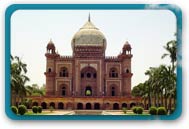  Safdarjung Tomb Safdarjung Tomb
Safdarjung's Tomb entombs Muqim Abul Mansur Khan, also known as Safdarjung. He was the viceroy of Awadh under the Mughal Emperor, Mohammed Shah and later became his prime minister. Nawab Shuja-ud-Daulah, Safdarjung's son, constructed Delhi Safdarjung's Tomb, the last garden tomb in the city, in the year 1753-54. The tomb consists of a number of charming pavilions namely Jangli Mahal, (Palace in the woods), Moti Mahal (Pearl Palace) and Badshah Pasand (King's favorite).
There is also a madrassa (Muslim School) inside the premises of the Tomb Of Safdarjang, Delhi. The red sandstone and buff stone monument comprises of the tomb, the courtyard and a mosque. There is a library over the main gateway, maintained by the Archaeological Survey of India (ASI). One of the last remnants of Mughal architecture, Safdarjung's Tomb is to some an extent like the Humayun's Tomb. It stretches over an area of 300-sq-metre and is set in the middle of a widespread garden.
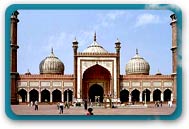  Jama Masjid Delhi Jama Masjid Delhi
Jama Masjid is one of the largest mosques in India, also known by the name of "Masjid-i-Jahan Numa" (visible to the world). Situated near the Red Fort in Delhi, it is one of the last monuments built by Mughal emperor Shah Jahan. Designed as Shah Jahan's primary mosque, Jamma Masjid of Delhi is built in red sandstone, with an extensive use of white marble. The interiors of the mosque are inlaid with stripes of black. It took six years to complete this simple yet elegant monument. Delhi Jama Masjid was built on a high platform so as to make it visible from all the neighboring areas.
Ostad Khalil, a great sculptor of his time, designed this mosque. Built as the replica of Moti Masjid in Agra, it has three gateways, four towers and two minarets. However, the most impressive feature of the mosque is its pulpit, carved out of a single block of marble. Gracing the portico of Jama Masjid, the slender minarets, one on each side, are approximately 130 ft high. As you enter inside the mosque, you step into a stadium like courtyard. Wide staircases and arched gateways are the trademark of the Jama Masjid of Delhi. The relic of the Prophet as well as the Holy Koran is shrine in a small shrine inside the mosque. |
| Back |
|
|
|
|
|
|
|
|
|
|
|
|
|
|
